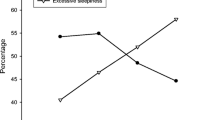Abstract
Purpose
Obstructive sleep apnea (OSA) is traditionally associated with excessive daytime sleepiness. Insomnia is characterized by hyperarousal, and is seen as a predominant feature in a subgroup of patients with OSA. The aim of this study was to describe the prevalence of comorbid insomnia and sleep apnea (COMISA) in a sleep apnea population and to characterize its features.
Methods
This was a chart review of patients who underwent overnight polysomnography (PSG). All patients completed questionnaires with the Epworth Sleepiness Scale (ESS), and symptoms of insomnia and other sleep-related comorbidities. Patients with OSA on the PSG were included.
Results
A total of 296 patients with OSA were included, of which 80% reported at least 1 major symptom of insomnia: 57% reported sleep onset insomnia, 68% sleep maintenance insomnia, and 48% had early morning awakenings. COMISA (OSA plus 2 or more major symptoms of insomnia) was seen in 63%. These patients were more likely to report an abnormal ESS score, gastroesophageal reflux (GER), and restless legs (RL) than those without; no difference was seen in self-reported sleep bruxism. Among the patients with COMISA, 85% reported at least 1 representative symptom of psychophysiological insomnia (PPI); each of the 5 PPI symptoms was present in at least 40% of patients with COMISA.
Conclusions
Insomnia is extremely prevalent in our population of patients with OSA, accompanied by daytime sleepiness and symptoms of PPI, GER, and RL. Further study is needed to determine the interactions between symptoms and OSA treatments in these patients.


Similar content being viewed by others
References
Peppard PE, Young T, Barnet JH, Palta M, Hagen EW, Hla KM (2013) Increased prevalence of sleep-disordered breathing in adults. Am J Epidemiol 177(9):1006–1014. https://doi.org/10.1093/aje/kws342
Younes M (2017) Fifty years of physiology in obstructive sleep apnea. Am J Respir Crit Care Med 196(8):954–957. https://doi.org/10.1164/rccm.201705-1044ED
Roth T (2007) Insomnia: definition, prevalence, etiology, and consequences. J Clin Sleep Med 3(5 suppl):S7–S10. https://doi.org/10.5664/jcsm.26929
American Academy of Sleep Medicine (2014) International classification of sleep disorders - third edition (ICSD-3), 3rd edn. American Academy of Sleep Medicine, Darien
Luyster FS, Buysse DJ, Strollo PJ (2010) Comorbid insomnia and obstructive sleep apnea: challenges for clinical practice and research. J Clin Sleep Med 06(02):196–204. https://doi.org/10.5664/jcsm.27772
Subramanian S, Guntupalli B, Murugan T, Bopparaju S, Chanamolu S, Casturi L, Surani S (2011) Gender and ethnic differences in prevalence of self-reported insomnia among patients with obstructive sleep apnea. Sleep Breath 15(4):711–715. https://doi.org/10.1007/s11325-010-0426-4
Iber C, Ancoli-Israel S, Chesson A, Quan S, Medicine AAoS (2007) The AASM manual for the scoring of sleep and associated events: rules, terminology and technical specifications. American Academy of Sleep Medicine, Westchester
Bahr K, Cámara RJA, Gouveris H, Tuin I (2018) Current treatment of comorbid insomnia and obstructive sleep apnea with CBTI and PAP-therapy: a systematic review. Front Neurol 9(804). https://doi.org/10.3389/fneur.2018.00804
Fung CH, Martin JL, Josephson K, Fiorentino L, Dzierzewski JM, Jouldjian S, Tapia JCR, Mitchell MN, Alessi C (2016) Efficacy of cognitive behavioral therapy for insomnia in older adults with occult sleep-disordered breathing. Psychosom Med 78(5):629–639. https://doi.org/10.1097/psy.0000000000000314
Sweetman A, Lack L, Bastien C (2019) Co-morbid insomnia and sleep apnea (COMISA): prevalence, consequences, methodological considerations, and recent randomized controlled trials. Brain Sci 9(12):371
Fung CH, Martin JL, Dzierzewski JM, Jouldjian S, Josephson K, Park M, Alessi C (2013) Prevalence and symptoms of occult sleep disordered breathing among older veterans with insomnia. J Clin Sleep Med 09(11):1173–1178. https://doi.org/10.5664/jcsm.3162
Lee M-h, Lee S-A, Lee G-h, Ryu H-S, Chung S, Chung Y-S, Kim WS (2014) Gender differences in the effect of comorbid insomnia symptom on depression, anxiety, fatigue, and daytime sleepiness in patients with obstructive sleep apnea. Sleep Breath 18(1):111–117. https://doi.org/10.1007/s11325-013-0856-x
Bjorvatn B, Lehmann S, Gulati S, Aurlien H, Pallesen S, Saxvig IW (2015) Prevalence of excessive sleepiness is higher whereas insomnia is lower with greater severity of obstructive sleep apnea. Sleep Breath 19(4):1387–1393. https://doi.org/10.1007/s11325-015-1155-5
Krakow B, Melendrez D, Ferreira E, Clark J, Warner TD, Sisley B, Sklar D (2001) Prevalence of insomnia symptoms in patients with sleep-disordered breathing. Chest 120(6):1923–1929. https://doi.org/10.1378/chest.120.6.1923
Krell SB, Kapur VK (2005) Insomnia complaints in patients evaluated for obstructive sleep apnea. Sleep Breath 9(3):104–110. https://doi.org/10.1007/s11325-005-0026-x
Hesselbacher S, Subramanian S, Allen J, Surani S, Surani S (2012) Body mass index, gender, and ethnic variations alter the clinical implications of the epworth sleepiness scale in patients with suspected obstructive sleep apnea. Open Respir Med J 6:20–27. https://doi.org/10.2174/1874306401206010020
Lichstein KL, Riedel BW, Lester KW, Aguillard RN (1999) Occult sleep apnea in a recruited sample of older adults with insomnia. J Consult Clin Psychol 67(3):405–410. https://doi.org/10.1037/0022-006X.67.3.405
Podlipnik M, Sarc I, Ziherl K (2017) Restless leg syndrome is common in patients with obstructive sleep apnoea. ERJ Open Res 3(suppl 1):P20. https://doi.org/10.1183/23120541.sleepandbreathing-2017.P20
Author information
Authors and Affiliations
Contributions
All authors contributed equally to study design, data acquisition and analyses, and manuscript preparation. All authors have approved the final manuscript.
Corresponding author
Ethics declarations
Ethics approval and consent to participate
Institutional review board approval was obtained prior to this research work, and it has been performed in accordance with the ethical standards laid down in the 1964 Declaration of Helsinki and its later amendments. The requirement for informed consent from participants was waived for this retrospective chart review.
Conflict of interest/Competing interests
The authors declare no conflict of interest or competing interests.
Additional information
Publisher’s note
Springer Nature remains neutral with regard to jurisdictional claims in published maps and institutional affiliations.
Rights and permissions
About this article
Cite this article
Subramanian, S., Hesselbacher, S.E., Nye, P. et al. Comorbid insomnia and sleep apnea: characterization of the syndrome and understanding its associations with comorbid sleep conditions. Sleep Breath 25, 1995–2000 (2021). https://doi.org/10.1007/s11325-021-02331-1
Received:
Revised:
Accepted:
Published:
Issue Date:
DOI: https://doi.org/10.1007/s11325-021-02331-1




